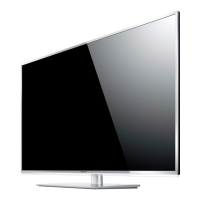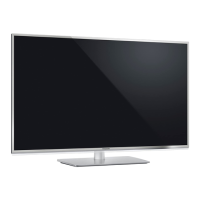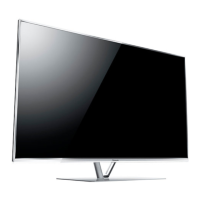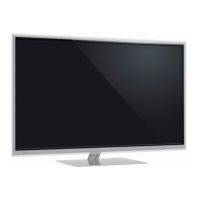Do you have a question about the Panasonic TX-L42E6K and is the answer not in the manual?
Gateway to TV, applications, and more for easy access to special features like Media Player and games.
Covers fundamental TV operations like basic connection, channel selection, information banner, option menu, and timer.
Instructions for connecting and operating external devices like VCRs, DVD players, and HDMI equipment.
Settings and adjustments for optimizing picture quality, including viewing mode, ambient sensor, and aspect ratio.
Settings for optimizing sound quality, including sound modes like Standard, Music, and Speech.
Information on using the Electronic Programme Guide (EPG) for channel and program listings.
Utilizing digital text services (MHEG) with graphics and text laid out by the broadcaster.
Instructions for navigating and adjusting teletext content, including revealing hidden data.
Understanding different teletext display modes like FASTEXT and List mode.
Options for retuning channels, creating favourite lists, and skipping unwanted channels.
Creating and managing lists of favorite DVB channels for quick access.
Skipping unwanted channels or editing existing channel lists for better organization.
Automatic channel search and tuning for receivable channels.
Sorting DVB channels based on signal quality or preferred region for optimal reception.
Searching for channels manually and adjusting frequency and signal quality for precise tuning.
Adding new channels, deleting removed ones, or renaming channels automatically.
Selecting notifications for new DVB channels found or not.
Checking the signal condition of a selected channel using quality indicators.
Accessing websites, videos, games, and communication tools via the APPS list.
Setting up wired or wireless connections for internet access.
Configuring wireless and wired network connections for optimal performance.
Connecting to a home network for sharing media and enjoying DLNA Certified features.
Establishing wireless or wired connections for DLNA and internet services.
Setting up quick wireless/wired connections and custom network configurations.
Supported photo file formats and their specifications, including JPEG resolution and sub-sampling.
Supported video file formats, codecs, and container types for AVI, MKV, ASF, MP4, FLV, etc.
Supported music file formats including MP3, AAC, WMA, LPCM, and FLAC.
Enjoying photo, video, or music from USB flash memory with various playback modes.
Choosing a device or mode (Photo, Video, Music) for media playback.
Managing photo playback, changing devices, and modes within the Media Player.
Viewing individual photos and navigating through them, with options for rotation and thumbnail view.
Sorting photos by folder, recorded date, or recorded month for easy organization.
Configuring and starting slideshows with various effects and background music.
Accessing applications like internet content, network content, and Media Player via the APPS list.
Overview of HDMI Inter-Operability features with Panasonic products for easy control and home theatre setup.
Connecting and setting up equipment for VIERA Link functionality, including cable connections and menu settings.
Automatic input switching when connected equipment is operating, simplifying user experience.
Automatically turns on the TV when connected equipment starts playback or activates functions.
Automatically sets connected equipment to Standby when the TV is in Standby mode.
Controls connected equipment power consumption in Standby mode for energy saving.
Automatically puts non-watched or non-used connected equipment into Standby mode to reduce power consumption.
Controlling connected equipment functions like playback and menu navigation using the TV's remote.
Selecting theatre speakers or TV speakers for audio output, and managing multi-channel sound.
Navigating menus to adjust picture, sound, network, timer, and setup functions.
Adjusting picture settings like viewing mode, brightness, contrast, noise reduction, and screen settings.
Configuring sound modes, equalizer settings, volume adjustments, and voice guidance.
Setting up network connections, status checks, VIERA remote settings, and other network options.
Setting timers for auto standby, no signal power off, and managing time zone.
Configuring eco navigation, TV guide, USB devices, child lock, tuning, language, and display settings.
Troubleshooting common issues related to picture, digital TV, analogue TV, sound, HDMI, and network.
Guidelines for care and cleaning of the TV display, cabinet, and pedestal.
Using the help menu for system and device information.
Information on optional accessories like Communication Camera and Wall-hanging bracket.
Information on trademarks, logos, and software licences.
Gateway to TV, applications, and more for easy access to special features like Media Player and games.
Covers fundamental TV operations like basic connection, channel selection, information banner, option menu, and timer.
Instructions for connecting and operating external devices like VCRs, DVD players, and HDMI equipment.
Settings and adjustments for optimizing picture quality, including viewing mode, ambient sensor, and aspect ratio.
Settings for optimizing sound quality, including sound modes like Standard, Music, and Speech.
Information on using the Electronic Programme Guide (EPG) for channel and program listings.
Utilizing digital text services (MHEG) with graphics and text laid out by the broadcaster.
Instructions for navigating and adjusting teletext content, including revealing hidden data.
Understanding different teletext display modes like FASTEXT and List mode.
Options for retuning channels, creating favourite lists, and skipping unwanted channels.
Creating and managing lists of favorite DVB channels for quick access.
Skipping unwanted channels or editing existing channel lists for better organization.
Automatic channel search and tuning for receivable channels.
Sorting DVB channels based on signal quality or preferred region for optimal reception.
Searching for channels manually and adjusting frequency and signal quality for precise tuning.
Adding new channels, deleting removed ones, or renaming channels automatically.
Selecting notifications for new DVB channels found or not.
Checking the signal condition of a selected channel using quality indicators.
Accessing websites, videos, games, and communication tools via the APPS list.
Setting up wired or wireless connections for internet access.
Configuring wireless and wired network connections for optimal performance.
Connecting to a home network for sharing media and enjoying DLNA Certified features.
Establishing wireless or wired connections for DLNA and internet services.
Setting up quick wireless/wired connections and custom network configurations.
Supported photo file formats and their specifications, including JPEG resolution and sub-sampling.
Supported video file formats, codecs, and container types for AVI, MKV, ASF, MP4, FLV, etc.
Supported music file formats including MP3, AAC, WMA, LPCM, and FLAC.
Enjoying photo, video, or music from USB flash memory with various playback modes.
Choosing a device or mode (Photo, Video, Music) for media playback.
Managing photo playback, changing devices, and modes within the Media Player.
Viewing individual photos and navigating through them, with options for rotation and thumbnail view.
Sorting photos by folder, recorded date, or recorded month for easy organization.
Configuring and starting slideshows with various effects and background music.
Accessing applications like internet content, network content, and Media Player via the APPS list.
Overview of HDMI Inter-Operability features with Panasonic products for easy control and home theatre setup.
Connecting and setting up equipment for VIERA Link functionality, including cable connections and menu settings.
Automatic input switching when connected equipment is operating, simplifying user experience.
Automatically turns on the TV when connected equipment starts playback or activates functions.
Automatically sets connected equipment to Standby when the TV is in Standby mode.
Controls connected equipment power consumption in Standby mode for energy saving.
Automatically puts non-watched or non-used connected equipment into Standby mode to reduce power consumption.
Controlling connected equipment functions like playback and menu navigation using the TV's remote.
Selecting theatre speakers or TV speakers for audio output, and managing multi-channel sound.
Navigating menus to adjust picture, sound, network, timer, and setup functions.
Adjusting picture settings like viewing mode, brightness, contrast, noise reduction, and screen settings.
Configuring sound modes, equalizer settings, volume adjustments, and voice guidance.
Setting up network connections, status checks, VIERA remote settings, and other network options.
Setting timers for auto standby, no signal power off, and managing time zone.
Configuring eco navigation, TV guide, USB devices, child lock, tuning, language, and display settings.
Troubleshooting common issues related to picture, digital TV, analogue TV, sound, HDMI, and network.
Guidelines for care and cleaning of the TV display, cabinet, and pedestal.
Using the help menu for system and device information.
Information on optional accessories like Communication Camera and Wall-hanging bracket.
Information on trademarks, logos, and software licences.
| Screen Size | 42 inches |
|---|---|
| Resolution | 1920 x 1080 pixels |
| Display Type | LCD |
| Backlight Type | LED |
| Smart TV | Yes |
| HDMI Ports | 3 |
| USB Ports | 2 |
| Wi-Fi | Yes |
| Refresh Rate | 100 Hz |
| 3D | No |
| Energy Efficiency Class | A+ |











